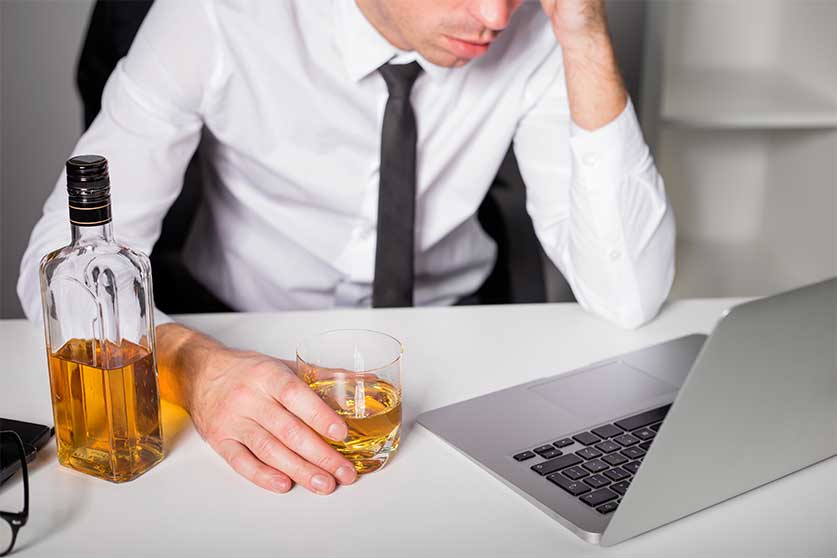Alcohol is among the most commonly abused drugs in the world. While anyone can develop an alcohol problem, people with certain jobs face a higher risk. Here are the top five occupations associated with heavy drinking.
1. Lawyers
According to the American Bar Association, one in five U.S. lawyers struggles with alcohol abuse. That’s twice the rate of the general population.
Similarly, a 2016 study of 12,000 U.S. lawyers found that 20.6% drank at a hazardous level. That means they drank to the point of facing serious health risks, such as liver disease, cancer, and alcohol poisoning (also called alcohol overdose).
The same study found that 28% of lawyers experience symptoms of depression, while 19% experience anxiety. Many lawyers develop these issues due to their high-stress work environments. To cope, some turn to alcohol.
This type of self-medication often leads to alcohol use disorder (also called alcohol addiction). Like other diseases, this condition is treatable.
Unfortunately, many lawyers avoid confronting their addictions and seeking treatment. They may fear that doing so could ruin their career. As a result, they hide their addictions, which get worse with time.
2. Miners
Mining jobs typically include long hours, isolation, and intense physical demands. They also come with a high risk of workplace accidents, a threat that can cause constant anxiety. All these factors make miners more likely to engage in substance abuse, including alcohol abuse.
According to a national survey by the Substance Abuse and Mental Health Services Administration (SAMHSA), 17.5% of miners reported heavy alcohol use in the past month, the highest rate of all industries surveyed.
The National Institute on Alcohol Abuse and Alcoholism (NIAAA) defines heavy alcohol use as:
- consuming more than 3 drinks per day or more than 7 drinks per week for females
- consuming more than 4 drinks per day or more than 14 drinks per week for males
The SAMHSA survey also found that miners had the third-highest rate of past-year substance use disorder.
3. Construction Workers
Like miners, construction workers face significant stressors, including intense physical demands and a high risk of injury. Some of them try to relax by drinking alcohol after (or even during) work.
Also, many construction workers have trouble finding steady work. During periods of unemployment, they may use alcohol to self-medicate feelings of anxiety or depression. They might also lack adequate health insurance, making it difficult to access treatment for alcohol addiction.
After the mining industry, the construction industry had the second-highest rate of past-month heavy drinking (16.5%), according to the SAMHSA survey.
Moreover, a 2020 report found that one in six construction workers has seen a colleague visibly impacted by alcohol while working. Drinking on the job significantly increases these workers’ risk of injury, which, as mentioned above, is already high.
4. Food Service Workers
Cooks, waiters, and other food service workers tend to work irregular hours, which can disrupt their sleep schedules. They also work in fast-paced, physically demanding environments.
Despite these demands, they often receive low wages and little to no benefits. To cope with these challenges, many food service workers drink before and after their shifts.
Some food service services even drink on the job, especially bartenders and other workers with easy access to alcohol. Managers often ignore this behavior, dismissing it as a normal part of the restaurant industry. They may even encourage employees to drink after a long or particularly difficult shift.
According to the SAMHSA survey, food service workers have the third-highest rate of past-month heavy alcohol use at 11.8%. They also have the highest rate of past-month illegal drug use.
5. Artists
When discussing on-the-job alcohol abuse, many people think of creative professionals, such as painters, writers, and musicians.
Indeed, the SAMHSA survey showed that people working in the arts and entertainment industry have the fourth-highest rate of past-month heavy drinking at 11.5%.
In addition, a 2017 study showed that artists have a higher risk of both substance misuse and mental illness. Artists with untreated mental illness often use alcohol to self-medicate.
They may also feel that drinking helps them unleash their creativity. It’s true that alcohol might help you express yourself by lowering your inhibitions. However, this effect is temporary.
Also, other effects of alcohol abuse, such as memory loss and trouble concentrating, will only hinder your creative process.
If you or someone you love feels unable to control your alcohol consumption, please reach out to Northeast Addictions Treatment Center.
Our board-certified healthcare providers offer medical detox, mental health counseling, and other evidence-based treatment options to help you or your loved one thrive.
Sources
American Bar Association — Alcohol Use Disorders
Drug & Alcohol Review — Construction workers’ alcohol use, knowledge, perceptions of risk and workplace norms
International Journal of Mental Health & Addiction — Substance Use and Psychological Disorders Among Art and Non-art University Students: an Empirical Self-Report Survey
Journal of Addiction Medicine — The Prevalence of Substance Use and Other Mental Health Concerns Among American Attorneys
National Institute on Alcohol Abuse and Alcoholism — Drinking Levels Defined
Substance Abuse and Mental Health Services Administration — Substance Use And Substance Use Disorder By Industry
Workplace Health & Safety — Alcohol Consumption in the Australian Mining Industry: The Role of Workplace, Social, and Individual Factors






